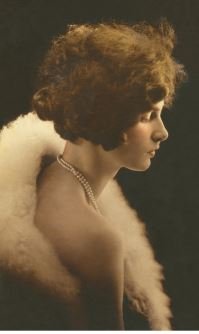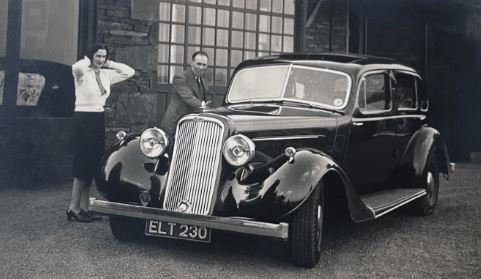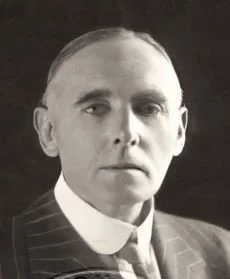Gay Dimond
(1904-2003)
When Fremantle woman Gay Dimond’s husband died she could have remained in Australia and worked as a secretary, the acceptable choice for most women at the time. Gay, however, wanted more from life; she was brave and created her own path, filled with exciting trips abroad and amazing experiences.
William Henry (1880-1950) and Margaretta McNeill’s Eldest daughter Gladys ‘Gay’ Margaretta was born on the 17 Aug 1904, in Boulder, WA. The family moved to Fremantle in 1906 when she was about 2 years old and they lived in a police house in Henderson St Fremantle, opposite the Police Court. William Henry McNeill was a hardworking police officer in Fremantle for many years. Gay’s mother was Catholic and her father was Presbyterian so as a compromise they agreed to bring their children up as Church of England. Religion was not allowed to be talked about with visiting relatives.
Gay attended the local Infants school and then went on to Princess May School for girls.
Her local church was St Johns in Fremantle. Gay liked to say “I was hatched, matched and I will be dispatched at St John’s” She attended Sunday school at the church and later taught Sunday school there as well.
In 1920 when Gay was 16, the family moved to ‘Waverley’ 82 Glyde St, East Fremantle (was 156 until 1939), where they lived from 1920 until 1963. It was then that Gladys changed her name to Gay.
After finishing school Gay attended Fremantle Technical School for two years studying typing shorthand, bookkeeping and later accounting. Her best friend at Tech was Elsie Gregson and her sister Maisie (Eva May) Gregson who lived close to Gay and whose father was also a policeman. During their time at Tech along with a couple of other girls, Hilda and Ivy, Gay and Elsie would go down to the Esplanade rocks and play songs on their combs. They called themselves “The Comb Band”.
1925 When Gay graduated she got a job working as a stenographer/secretary in the legal firm of Darbyshire and Gillett in St Georges Tce, Perth. Mr Eric William Gillett joined Benjamin Harvey Darbyshire in partnership in 1925. Nancy Rampant (later Rosman) was Mr Darbyshire’s secretary and Gay was probably Mr Gillet’s secretary. The two girls became good friends and worked together for a number of years.
Mr Darbyshire had links to practises in country towns including Albany. Gay’s parents were worried about her health, and when she had the opportunity to work in Albany it was considered that moving to the bracing air of Albany would be good for her. So in 1929 Gay moved to Albany to work for solicitor Mc Allum Henning of Hudson & Henning solicitors, Stirling Terrace, Albany. She stayed with William and Nellie Whimpey and became good friends with their daughter Gwen. Gay enjoyed the freedom she had in Albany and that is probably where her lifelong love of travel was born.
In 1934 Gay’s brother Keith, aged only 23, died of tuberculosis, at home on the 1 January, and after four years in Albany, Gay returned to Fremantle. Her sister Marjorie Isobel also married James Treloar in Fremantle. This marriage broke down and ended by 1941.
On the 31 March 1936 Gay’s engagement to Fredrick ‘Fred’ Martyn Dimond (1889- 1941) was announced. Fred Dimond was from a wealthy, well-educated London family. His grandfather had been a solicitor and his father a London stock broker. His mother died in 1905 and in 1911 when he was studying at Cambridge, his father employed a married couple as servants to manage the house and his needs. [vii] In 1914 Fred’s father died and both he and his younger brother John Martyn (1891) enlisted in the army. They both served in the Royal Army Service Corps in WW1, Fred as a Captain and John as a Lieutenant. Fred saw action in France. [viii] After the war John became a public Notary and stayed in the U.K whereas Fred travelled to Australia.
Fred arrived in Perth in 1928 and with Harvey G Duncan, became partners in a Advertising firm called Harvey G. Duncan and Co., at Goldsbrough House on St George’s Terrace, Perth. [vi] Fred managed the finances and Harvey brought in the clients. The business died by 1933 when the charismatic Harvey left and the Depression had ramifications on local business.
In June 1936 friends gathered for afternoon tea at the Wentworth hotel to celebrate Gay’s wedding and to say farewell. Among the friends who attended were Nancy Rampart (now Rosman), her friend from Darbyshire and Gillett, Mrs Nellie Whimpey, Elsie Gregson, Aida and Roma Sheridan and her mother and sisters Evelyn and Verna.[i] [ii]
Gay married Fred Dimond at St. John's Church, Fremantle on the 24th of June 1936. He was 47 and she was 32. They must have married early in the morning as they sailed to the eastern states on the Katoomba which left from Victoria Quay at 11am the same day. Due to heavy storms in the ‘Bight’ they changed ships twice and finally boarded the ship Port of Wellington in Brisbane. The ship called in at Townsville, Wyndham, Ceylon, Suez, Port Said and Malta; arriving in Hull, England in September 1936. [iii] [iv] [v]
Gay and Fred enjoyed the next few years living in London, where Gay saw snow for the first time. She organised holidays for herself Fred and his brother John. In 1938 they hired a car (27 Humber) and drove around Scotland and Wales, staying in heritage pubs and visiting historic sites.
In 1939 when war broke out, Frederick, aged 50 re-enlisted in the Royal Army Service Corps. He later became a captain in the West African Army Service Corps and also served in the Royal West African Frontier Force. They must have decided that it would be safer for Gay to go home to Australia during the war so on the 17th of October 1939 Gay flew back to Australia on the Empire Flying Boat Ceres. The flying boat had a flight time of only ten days from Southampton to Sydney compared to more than 40 days by sea. It provided a first class service only, which was out of reach of most Australians as a ticket cost the equivalent of an annual salary. (ix) See map
In May 1940 Gay’s sister Evelyn Joyce, who worked as a dressmaker, died of TB at the age of 33.
In 1941 Fred was deployed to Africa to help manage resources and indigenous service personal. [x] On the 4 April 1941 some officers and civilians went swimming in the sea, including Fred, who got into difficulties. Officers immediately went to his aid but the surf was too strong and in the attempt to save Fred a number of others got into trouble and tragically - both Fred and Morris Llewellyn Johns, drowned. Fred and Morris are buried in Christaborg Civil Cemetery, Accra Ghana. [xi] [xii]
Gay was totally devastated when she received the news. She remained in Australia for the duration of the war and shortly after the war had ended in Europe, in May 1945 she travelled back to the U.K on the ship Rangitiki. Gay still had possessions in a flat in London which had been badly damaged during the bombings and needed to sort out her affairs and matters to do with Fred’s death. [xiii]
She wrote home to friends of how distressing it was to see all the destroyed buildings and how the people in London were still suffering. She said there was no rejoicing for their first Christmas of peace; people were concerned about shortages of everything including coal to keep warm. (reference)
To cope with her grief Gay kept herself busy visiting museums and galleries with friends. She met with her brother-in law John regularly and often had lunch or dinner with him.
In 1946 while Gay was in the U.K she took part in an Australian publicity campaign in Scotland. There was an exhibition in Perth, Scotland designed to show Perth, Western Australia, with a general background of Australia. Gay acted as one of the information officers answering inquires at the exhibition. [xv]
In June 1947 Gay lived in a flat at 21 Nevern Place near Earl’s Court, and worked as a secretary. Gay really enjoyed the theatre and combined her talent for writing with her passion for the arts- writing paid reviews of live theatre and plays for the publishing firm of Frederick Muller Ltd.
Gay also loved travel and organised many holidays with brother-in-law John Dimond, who she was good friends with. In 1947 Gay made all the arrangements for a week’s holiday in Paris. Paris was still recovering after the war and Gay and John used the Guide book “How to see Paris for the soldiers of the Allied Armies”.
The following year, 1948 Gay organised a two week holiday with John in Cypress, then under British control. They flew on a Vickers-Viking which stopped in Marseilles to refuel and continued onto Rome where they stayed overnight. The following day they flew to Bari, Athens and Cyprus:
“It is not so spacious as the Flying Boat of my 1939 experience. The windows are smaller, and there are seats on both sides with a narrow aisle between. In the flying boat there was a spacious promenade aisle on one side. The seats do not tip back so far, and the tables are smaller. In fact everything is on a smaller scale, but it is very comfortable. The only real cause I have for complaint is in the placing of the wings - they are below the windows and somewhat obstruct the immediate view. In the flying boat the wings were above the windows. And so far I have not seen an altimeter AND WE HAVE NOT BEEN GIVEN MAPS.” (Gay’s trip diary)
They arrived at Nicosia and stayed at the Dome Hotel in Kyrenia.
“Our hotel, the Dome was brilliantly lit and seemed a large spacious place. English frugality ill prepares one for the sumptuous meals served abroad. I was almost afraid to eat my ham and eggs (two!) fruit and toast. The dining room overlooks the sea a great purple expanse of it between the islands and the coast of Turkey.”
The main problem they encountered during the holiday was buying petrol for the car they hired. It was strictly controlled and a lot of paper work was needed to obtain petrol and the island administration moved very slowly.
Gay’s parents were aging and in 1949 she returned to the family home in Glyde Street to help care for them. Living at home were her brother Allen, and her sister Verna, her husband Charles Smith and daughter Pamela. [xvi] On 15 December 1950 her father William died and two years later, in December 1952, her mother Margaretta followed him.
Gay continued to live at the family home. She enjoyed writing and kept a diary most of her life; as well as the theatre reviews she had written in the UK she also wrote articles for newspapers. In 1954 she had a short story “Swan Song” published in the Western Mail. [xvii]
In 1955 Gay sailed from Melbourne to Dover on the Ship Melbourne Star. Her occupation was listed as Journalist, however, she primarily worked as a secretary for the London Times. [xviii]
Gay worked hard and saved so she could travel. She organised many short holidays in the UK and abroad with brother-in-law John and other friends. Gay wrote of a memorable week’s holiday revisiting Paris with a friend called Doreen in 1959.
John and Gay took the train up to Chichester to visit a relative Pamela and her husband. At the time Pamela’s daughter Diana was about 14 and recalled that Gay “seemed so glamorous with such an exciting job at the London Times”. She recalled Gay telling her about her work as a secretary for the National Gallery during a fund raising project to save the Da Vinci Cartoon. [xix]
Often in her diaries Gay admitted that she didn’t enjoy cooking or housework and wished she had more money to live a better lifestyle. She enjoyed reading and had a thirst for knowledge and studied shorthand, French and Italian at night school. In October 1962 Gay flew to Rome and stayed with her friend Brenda. She was hoping to teach English to Italians but this did not eventuate and she worked as a secretary until August 1963, then travelled around Italy for a few weeks before returning to the U.K
The following year 1964 she was holidaying with John at Lake Vrynwy, in Wales. John collapsed in his room that night and died the following day. Gay was shocked and upset at John’s death. She wrote in her diary:
“Just a week before I was so happily packing to go on our holiday. Dear God how lost and lonely I felt on my return. No-one to speak to until I met the small group of mourners at the funeral.”
John had made a Will in 1948, which set up a trust fund that would pay Gay the income from the investments for the rest of her life.
In 1968 Gay returned to Australia and as the family home in Glyde St had been sold, found a flat at 2/16 Parliament Place, West Perth. Retired, she spent the rest of her life in Perth, taking frequent visits to the eastern states to see friends and relatives.
The people, who knew Gay in her latter years commented that she was extremely well read, interested in world affairs and had a great sense of humour and sharp wit. She was a progressive thinker and very appreciative of things people did for her. Gay was a very positive person considering the death of so many people close to her and the subsequent sadness she felt
Gay reconnected with Diana Corbyn, a relative of her husband who she met as a teenager in Chichester back in 1962. They shared a love of theatre and the arts and became good friends. As Gay aged Diana became a wonderful support for Gay and around 1996 with Diana’s help Gay moved to into Braemar Villiage. The staff cared for Gay and she had numerous visitors during her final 6 years of residency.
Gay died on the 14 Feb 2003, aged 98. [xx]
The funeral service was conducted at “her church”- St John’s Fremantle and Gay is remembered on the Family Grave in Fremantle cemetery.
Researched and written by Lee-Anne Percival 2021 <perci1@iinet.net.au>
Thanks also to Pam Baumgartner, Diana Corbyn and Debbie Hodgson
Edited by Jo Darbyshire 2021, Museum of Perth
[i] ‘ENGAGEMENTS’, West Australian, 31 March 1936, http://nla.gov.au/nla.news-article25137353.
[ii] ‘Tennis Club Dance’, West Australian, 23 June 1936, http://nla.gov.au/nla.news-article40727519.
[iii] ‘Family Notices’, West Australian, 19 August 1936, http://nla.gov.au/nla.news-article40743851.
[iv] ‘KATOOMBA FOR EASTERN STATES.’, West Australian, 25 June 1936, http://nla.gov.au/nla.news-article40728261.
[v] ‘Overseas Lines.’, Cairns Post, 4 July 1936, http://nla.gov.au/nla.news-article41759068.
[vi] ‘Advertising’, West Australian, 3 February 1931, http://nla.gov.au/nla.news-article33236478.
[vii] ‘1911 England Census’ (The National Archives of the UK (TNA) Series RG14, 1911., 1911).
[viii] ‘UK, World War I Service Medal and Award Rolls, 1914-1920 - Ancestry.Com.Au’, accessed 3 December 2020, https://search.ancestry.com.au/cgi-bin/sse.dll?indiv=1&dbid=5119&h=631243&ssrc=pt&tid=64566533&pid=36130097421&usePUB=true.
[ix] rebeccah, ‘Flying Boats: Sydney’s Golden Age of Aviation’, Sydney Living Museums, 19 May 2014, https://sydneylivingmuseums.com.au/stories/flying-boats-sydneys-golden-age-aviation.
[x] Oliver Coates, ‘New Perspectives on West Africa and World War Two: Introduction’, Journal of African Military History 4, no. 1–2 (26 October 2020): 5–39, https://doi.org/10.1163/24680966-00401007.
[xi] ‘Ancestry.Com. London, England, Electoral Registers, 1832-1965’ (Electoral Registers. London, England: London Metropolitan Archives., 1939).
[xii] ‘Casualty Details | CWGC’, accessed 3 December 2020, https://www.cwgc.org/find-records/find-war-dead/casualty-details/2389241/FREDERICK%20MARTYN%20DIMOND/.
[xiii] ‘Ancestry.Com.Au - UK and Ireland, Incoming Passenger Lists, 1878-1960’, accessed 20 October 2021, https://www.ancestry.com.au/imageviewer/collections/1518/images/30807_A001210-00221?pId=23440656.
[xiv] ‘Londoners Are Shabby, Pale, Thin, Hungry’, Mirror, 3 November 1945, http://nla.gov.au/nla.news-article76018330.
[xv] ‘PERTH SHOWN TO PERTH’, Daily News, 18 September 1946, http://nla.gov.au/nla.news-article78264543.
[xvi] ‘Ancestry.Com. Australia, Electoral Rolls, 1903-1980 [Database on-Line].’ (Australian Electoral Commission. [Electoral roll]., 1980 1903).
[xvii] ‘Swan Song’, Western Mail, 23 September 1954, http://nla.gov.au/nla.news-article39368204.
[xviii] ‘Ancestry.Com.Au - UK and Ireland, Incoming Passenger Lists, 1878-1960’, accessed 11 October 2021, https://www.ancestry.com.au/imageviewer/collections/1518/images/30807_A001332-00041?pId=5064287.
[xix] ‘Leonardo Fund Launched’, The Times, 31 March 1962, The Times Digital Archive, http://0.link.gale.com/apps/doc/CS136405631/GDCS?sid=bookmark-GDCS&xid=e19a5d33.
[xx] ‘Ancestry.Com. Australia, Electoral Rolls, 1903-1980 [Database on-Line].’
Gay Dimond nee McNeill c 1960s


















